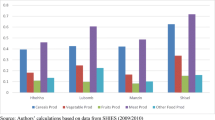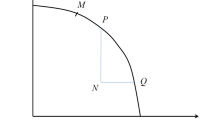Abstract
According to household production function theory households combine marketed goods and nonmarket environmental goods to produce service flows of direct value to the household. This readily explains why, as an input to household production activities, households might have preferences over the climate. Using techniques more frequently employed to account for differences in the demographic composition of households we use household production function theory to estimate climate equivalence scales using household expenditure data drawn from 51 Japanese cities over the period 2000–2009. Our results indicate that warmer temperatures result in a small but statistically highly significant reduction in the cost of living. Combining these estimates with climate change scenarios associated with the IPCC A2, A1B, and B1 emissions scenarios other things being equal points to a slight reduction in Japanese households’ cost of living.

Similar content being viewed by others
Notes
Henceforth we ignore the role of household labour in the production of service flows.
Writing the utility function of a household in location i as v(p(zi), y(zi), zi) where v is utility, p is a vector of prices and z is climate the direct effect of climate on households is the direct effect of zi on vi and not the indirect effect via p and y. We do not measure the value of a change in climate in alternative location j even if the household does have preferences over zj.
It may be for this reason that researchers, intent on estimating the economic costs of climate change, have focused attention on measuring changes in agricultural productivity or the cost of building sea defenses.
Climate equivalence scales are analogous to household equivalence scales but include climate variables rather than, as is more commonly the case in economics, the numbers of adults and children.
The compensating surplus (CS) is implicitly defined by the difference in income required to maintain welfare constant as environmental quality changes from z0 to z1.
$$ v\left( {p,y - CS,{z^0}} \right) = v\left( {p,y,{z^1}} \right) $$Revealed preference techniques use spatial variation in climate as an analogue for future climate change. In so doing, they address the issue of adaptation by making comparisons between households that have already perfectly adapted to the climate.
For a discussion of the circumstances in which compensation for nonmarket goods should occur in the housing market rather than the labour market or vice-versa see Roback (1982).
The more diverse the climate the easier it is to identify households’ preferences for particular types of climate.
On the assumption of common tastes see Stigler and Becker (1977).
These techniques are described in more detail in the next section.
In fact he analyses per capita expenditures rather than household expenditures.
For an example of an environmental valuation study which does not use demographic scaling see Shapiro and Smith (1981).
We note that scaling is not the only way of pooling data from households with a different demographic composition.
This relates to Engel’s claim that a comparison of the money income of households of different size but with the same food share would yield a household equivalence scale (Engel 1895).
Expenditure and price data used for analysis are all downloaded at http://www.e-stat.go.jp.
Data are downloaded at http://www.data.jma.go.jp/obd/stats/data/en/smp/index.html.
We use meteorological data from Kumagaya which is 40 km from Saitama; Hikone which is 55 km from Otsu; Yokohama which is neighbouring Kawasaki; and Iizuka which is 40 km from Kitakyushu.
Although Japanese HES data does exhibit relative price variation this is insufficient to identify separate commodity scales. Maddison (2001a, b) solves the problem of too many parameters by aggregating the data into four expenditure categories thereby enabling him to estimate separate equivalence scales for each commodity. But the process of aggregation obscures the precise role of climate just as much as estimating a single commodity scale does.
For this reason in what follows β10 is not separately estimated. It is customary to estimate demand equations in share form in order to combat heteroscedasticity.
Here as in many other studies the price index is approximated.
As expected the AIDS offers a much improved fit to the data. This is the finding of many other papers that have compared the LES and the AIDS models of consumer demand.
It is not possible to test whether the Hicksian matrix of compensated price elasticities is negative semi definite but this can be assessed by examining the eigenvalues of the matrix.
The results for the AIDS model without symmetry and homogeneity imposed are very similar.
Information on degree days is taken from http://www.degreedays.com.
Most analyses employ as we do, 30-year averages for climate but data from http://www.degreedays.com goes back only 5 years.
References
Asano S (1997) Joint allocation of leisure and consumption commodities: a Japanese extended consumer demand system 1979–90. Jpn Econ Rev 48:65–80
Asano S, Fukushima T (2006) Some empirical evidence on demand system and optimal commodity taxation. Jpn Econ Rev 57:50–68
Barten AP (1964) Family composition, prices and expenditure patterns. In: Hart PE, Mills G, Whitaker (eds) Econometric analysis for national economic planning. Butterworth, London
Becker G (1965) A theory of the allocation of time. Econ J 75:493–517
Bradford D, Hildebrand G (1977) Observable public good preferences. J Public Econ 8:111–131
Cragg M, Kahn M (1997) New estimates of climate demand: evidence from location choice. J Urban Econ 42:261–284
Deaton AS, Muellbauer J (1980) An almost ideal demand system. Am Econ Rev 70:312–326
Engel E (1895) Die Lebenskosten Belgischer Arbeiter-Familien fruher and jetzt. Int Stat Inst Bull 19:1–74
Frijters P, Van Praag B (1998) The effects of climate on welfare and wellbeing in Russia. Clim Chang 39:61–81
Maddison D (2001a) The amenity value of the climate of Britain. In: Maddison D (ed) The amenity value of the global climate. Earthscan, London
Maddison D (2001b) The amenity value of the climate: the household production function technique. In: Maddison D (ed) The amenity value of the global climate. Earthscan, London
Maddison D (2003) The amenity value of climate: the household production function approach. Resour Energy Econ 25:155–175
Maddison D, Bigano A (2003) The amenity value of the Italian climate. J Environ Econ Manag 45:319–332
Mendelsohn R (2001) A hedonic study of the non-market impacts of global warming in the US. In: Maddison D (ed) The amenity value of the global climate. Earthscan, London
Nordhaus W (1996) Climate amenities and global warming. In: Nakicenovic N, Nordhaus W, Richels R, Toth F (eds) Climate change: integrating science, economics, and policy. IIASA, Laxenburg
Pollak R, Wales T (1981) Demographic variables in demand analysis. Econometrica 49:1533–1551
Rehdanz K, Maddison D (2005) Climate and happiness. Ecol Econ 52:111–125
Rehdanz K, Maddison D (2009) The amenity value of climate to German households. Oxf Econ Pap 61:150–167
Roback J (1982) Wages, rents and the quality of life. J Polit Econ 90(6):1257–1278
Shapiro P, Smith T (1981) Preferences or non-market goods revealed through market demands. In: Smith V (ed) Advances in applied microeconomics vol. 1 JAI Press, Greenwich, CT, pp. 105–122
Smith V (1991) Household production function and environmental benefit estimation. In: Braden J, Kolstadt C (eds) Measuring the demand for environmental quality. Elsevier Science Publishers, North Holland
Stigler G, Becker G (1977) De Gustibus Non Est Disputandum. Am Econ Rev 67(2):76–90
Stone J (1954) Linear expenditure systems and demand analysis: an application to the pattern of British demand. Econ J 64:511–527
Van Praag B (1988) Climate equivalence scales: an application of a general method. Eur Econ Rev 32:1019–1024
Author information
Authors and Affiliations
Corresponding author
Appendix
Appendix
Rights and permissions
About this article
Cite this article
Maddison, D., Rehdanz, K. & Narita, D. The household production function approach to valuing climate: the case of Japan. Climatic Change 116, 207–229 (2013). https://doi.org/10.1007/s10584-012-0478-5
Received:
Accepted:
Published:
Issue Date:
DOI: https://doi.org/10.1007/s10584-012-0478-5




